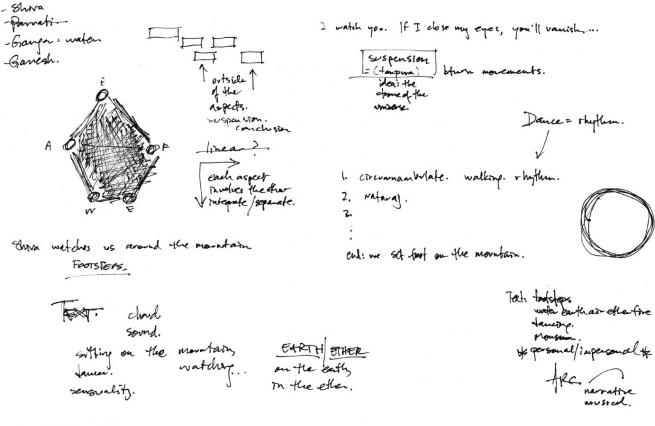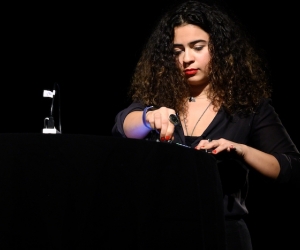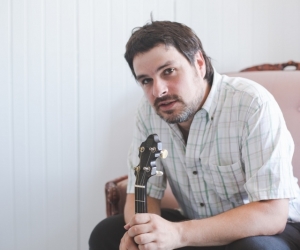
“La montaña. El cuervo. Cada mota de polvo elevada por mis pasos alberga incontables palabras,” intones the deeply resonant voice, as the rhythmic sound of footsteps fades up and a single gong-stroke repeats slowly.
This is Kailash, a radiophonic work by Toronto’s Debashis Sinha, commissioned from him in 2009 by Centro para la Difusión de la Música Contemporanea (Madrid) and Radio Clasicá/RNE (Spanish National Radio) after Sinha won the XIV Radio Creation Works competition. The twenty-two-minute-long radio work is a first for percussionist and composer Sinha, who has trained under master drummers from many world traditions and has played with several of Canada’s intercultural music groups. In the last five years he has made serious forays into the worlds of solo performance, audio art, media art, and video music. In composing Kailash, Sinha drew on the creative processes and methodologies developed in these works and on his experience growing up as a Canadian of Bengali heritage. He is guided by a fierce commitment to expressing the experience of life in and between cultures.
Kailash, as described in its program note, is a radiophonic work that simultaneously expresses the imagined thoughts of the Hindu god Shiva and the imagined sound world of the summit of Mount Kailash in the Himalayas, where Shiva is said to dwell. No human has ever set foot on the mountain, nor scaled its summit—out of deference to Hindu and Buddhist belief. This unknown sound world in which Shiva dwells is the principal aural element in the piece, filtered through the aspects of Shiva—Earth, Air, Water, Fire, and Ether.
I began our conversation by asking him about the commission and how he approached writing his first long-form radiophonic work.
MICHELINE ROI: You are a performer, a percussionist, and a South Asian who, with this commission, was given an opportunity to express yourself in a long-form radiophonic piece which has a very strong European tradition. How did you approach writing the piece?
DEBASHIS SINHA: I was interested in the challenge of creating something that would be engaging for an extended time. The genre and structure of long-form radio was something I was very interested in. At that point in time I was also thinking that I hadn’t been doing any drumming or working with rhythm, even though I spent so many years learning how to play these instruments and learning about rhythm and time and developing all those skills. It’s part of my voice—a big part of my voice. For a long time I rejected it in my solo work, and felt it was trivial. But when I think about rhythm, I think about Shiva, who is often portrayed as the dancer Nataraja. He’s really connected to that—percussion and dance and rhythmic cycles, which are all very highly developed in South Asian music.
MR: In your visual sketch of the piece’s elements I notice that you have drawn a pentagon with the letters E, F, E, W, and A. What does that represent in the piece?
DS: Earth, fire, ether, water, and air—the aspects of Shiva—were going to be structured as separate movements. Apart from these aspects, I also wanted to have a kind of parallel influence running through the piece—the sound of Kailash. What does it sound like? That, and what Shiva was thinking in this beautiful sound world that we know nothing about . . . I wanted them all to run parallel to each other.
MR: How did these ideas translate into the sound of the work?
DS: To me, Kailash sounds like the mountain. The mountain is full of sound—everything that’s ever made a sound, everything that ever will make a sound, all the sounds that have stopped but left their mark on a piece of space-dust or a star. All that sound is there, and I think it’s there because it’s Kailash and because Shiva dwells there.
MR: Tell me about your sound sources. Each of these elements you’ve discussed—earth, air, water—are real-world sounds.
DS: I knew pretty quickly that I did not want to use, for example, field recordings of wind. Most of the sound sources started from working with percussion instruments or acoustic sounds. Footsteps were interesting—I was thinking about what footsteps mean, and how they’re rhythmic; and people walking around the mountain was a big image for me. I wanted to use a lot of percussion and rhythm, and wanted to abstract and work with these sound sources the same ways that I’ve done in the past—granular synthesis and stretching, for example.
MR: Is there an Earth sound?
DS: Kind of. The Earth sound for me permeates the piece somehow, because of the use of rhythm and repetitive sounds like the footsteps or loops of things—for me that’s kind of that.
MR: You mentioned that Shiva’s thoughts are another structural element in the piece, is that what the words “I watch you. If I close my eyes, you’ll vanish” refer to in your sketch?
DS: Yes. I chose to write some text about what Shiva might be thinking or what he’s seeing as we’re all going about our business. There’s a lot of baggage around texts for me. But for Kailash I thought, Okay, it’s time for me to be fearless. Why not?
MR: Did your experience as a performer inform your compositional approach?
DS: I read something somewhere that says ‘composition is performance slowed down.’ That’s really been a big influence on me. In general I have to know what a piece is about first, then I just turn on the computer with a microphone and start working.
MR: It sounds like you have a very intuitive way of working—really staying in the moment and listening hard.
DS: That’s exactly it. But if I hadn’t done that headwork first, for me, I would not have been able to get through the piece in the same way.
Audio: Kailash (Excerpt, 2009). Composed by Debashis Sinha. Image: Sketches from Sinha's Kailash. Image by: Courtesy of Debashis Sinha.


